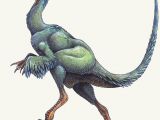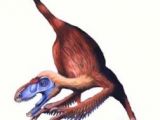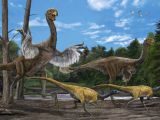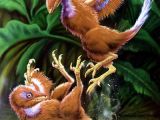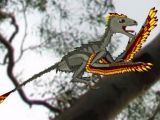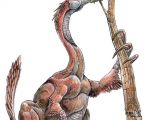If you had walked the Earth 150 to 65 million years ago, the birds would have seemed very strange to you. First, they all displayed a mouth full of fearsome teeth. Too few flew, and many had well developed arms, with a lizard-like tail covered by feathers.
In fact, all these strange birds were not birds at all, but dinosaurs. Feathered dinosaurs. Indeed, birds evolved from them, so up to a point, most researchers say birds are just living dinosaurs, and sometimes, they even think some of the feathered dinosaurs evolved from primitive birds. All the feathered dinosaurs belonged to the Coelosauria branch of the carnivorous group of dinosaurs.
1. Sinosauropteryx ("Chinese lizard-wing") is the most primitive feathered dinosaur ever found, the size of a hen. It lived in China during the early Cretaceous period (130 million years ago). It was no longer than 1-1.20 m (3 ft), most of which was represented by the long tail. The feathers of Sinosauropteryx were very simple, similar in look to the secondarily primitive ones of the modern kiwi.
Feathers emerged in the family of Sinosauropteryx (Compsognahtidae), and some of its related species were only partially covered by feathers.
2. The huge T-rex was a Coelosauria dinosaur! (but not all the huge carnivorous dinosaurs belonged to the Coelurosauria family). A primitive species from its family (Tyrannosauridae) found in China, Dilong paradoxus, was covered by primitive feathers. Tyrannosaurus and other related species could have had feathers!
But skin impressions from adult tyrannosaurids in Canada and Mongolia reveal pebbly scales like in other dinosaurs. Now researchers believe that like in super-sized mammals (elephants, hippopotamus, and rhinoceros), adults lost feathers as they retained too much heat. The Cretaceous climate, that is when the T-rex lived, was indeed hot. Perhaps adult T-rexes still had feathers just on some body parts.
3. Microraptor is a four-winged dinosaur, weighing one kilogram, aged 125 million years, which lived in the territory of today's China. This dinosaur used the two upper wings as well as two lower wings in an aerodynamic design similar to the biplanes of the early XXth century. Scientists believe that the first birds, too, flew using four wings like Microraptor, but the pattern proved ineffective and abandoned during the evolution. Pedopenna, another dinosaur, presented a similar flight.
4. Bambiraptor was a 75-million year old carnivorous feathered dinosaur roaming North America. It was small, like most bird-like dinosaurs: less than 0.3 meters (1 ft) off the ground, 0.7 meters (2.3 ft) in length, and a 2 kilograms (4.4 lbs) weight.
Bambiraptor had opposable fingers 75 million years ago, 15 millions years before the most primitive primates developed opposable thumbs. Bone models showed that Bambiraptor would have been able to grip prey with both arms, or employ its long arms to bring objects to its mouth.
The minute dinosaur could have positioned the tips of the outer two of its three fingers together, the way a human can touch the tip of the thumb with the tip of the middle finger.
Bambiraptor surely had long feathers on its arms, which could have interfered with the use of its hands, but maybe the hands extended beyond the feathers.
5. Archaeopteryx ("ancient wing") is regarded as the most primitive encountered bird. It lived during the Jurassic Period around 155-150 million years ago in Europe.
Unlike modern birds, Archaeopteryx had thecodont teeth (like in dinosaurs), three fingers on the tip of its wing with curved claws, and a large tail consisting in flesh, bone and feathers (not just feathers, like in modern birds). The first Archaeopteryx was discovered in 1861 in a limestone quarry in Bavaria. Its feathers were 6 cm (2.4 in) long. Just 7 individuals have been discovered in 150 years. Gastric content shows Archaeopteryx ate fish, but it could have also eaten insects and the fingers show it could climb trees. Archaeopteryx is one of the first fossils confirming the theory of evolution.
Only during the Cretaceous, 120 MA ago, birds that lost their bonny tail, like the Iberomesornis, are recorded.
6. "Jurassic Park" made it famous, but with a gross blooper. Velociraptor (which in fact, lived in the Cretaceous era, not in the Jurassic) was feathered. Velociraptor forearm fossil bones clearly bear quill knobs, bony bumps to which the large secondary feathers of the wing, involved in flight in modern birds, are attached to the bones with ligaments. The Velociraptor was a small species, up to 2.07 m (6.7 ft) long (over half of which was the long tail) and weighing 15 kg (33 lb).
7. Troodon was a feathered dinosaur from the Late Cretaceous Period (75-65 mya) of North America. It was 2 m (6.5 ft) long, 1 m (3 ft) tall, and weighed 60 kg (130 lb). It had large, retractable sickle-shaped claws on its second toes, kept raised off the ground when running.
Troodon possessed one of the relatively largest known brains any other dinosaur had, comparable to that of modern birds, that's why it's regarded as the most intelligent dinosaur.
Many speculate that if dinosaurs had not disappeared, Troodon could have evolved in a highly intelligent creature like humans, the dinsauroid.
8. Some feathered dinosaurs looked very much like modern ostriches, lacking teeth that were replaced by a beak, and having long legs and necks, and small heads (Ornithomimosaurs).
Their scientific names, like Struthiomimus (ostrich mimic), Gallimimus (cock mimic), Pelecanimimus (pelican mimic) point to their resemblance to birds.
Oviraptorosaurs ("egg thief lizards") were also a group of beaked, feathered dinosaurs from the Cretaceous Period in Asia and North America. Most of this species are so similar to birds that some scientists regard them as true birds, more evolved than Archaeopteryx. Oviraptor (misleadingly meaning "egg seizer") is the best known species of this group. Its name means "egg thief" is misleading: researchers believed the animal ate the eggs of other dinosaurs, while in fact the encountered fossils were oviraptors incubating their own eggs, 18 cm long and 6.5 cm wide. The Oviraptor incubated 20 eggs disposed in 2 concentric circles, with the base towards the center of the nest.
The Chinese Protoarchaeopteryx, 145 million years old, resembled somehow Archaeopteryx but it had symmetrical feathers on the fore limbs, thus it did not fly. It was the size of a turkey. The tail of the tip had long feathers.
The largest oviraptosaur was Gigantoraptor, discovered in China's Gobi Desert. The ostrich-like dino was as big as a rhino (around 1.5 tons) and 16 ft (5 m) tall, and was toothless (in a time when most birds were toothed!). Gigantoraptor lived 70 million years ago. It has some herbivorous traits like a small head and a long neck, but it was equipped with fearsome claws 20 cm (8 inches) long.
9. Therizinosaurus ('scythe lizard') was 10-12 m (33-40 ft) long and reached 3-6 tons in weight. It lived in the late Cretaceous Period (70 million years ago) in Mongolia and had a beaked small head and a long neck. It walked on two feet and the body was large. The front limbs of this dinosaur and all its relatives had three gigantic claws, in this species up to 3 ft (1 m) ) long.
Unlike other feathered dinosaurs, this one was most probably a herbivore, using its long arms and claws to grab foliage from trees. The claws could have been employed against predators or in male fights for territory or for mating.
10. Epidendrosaurus ("upon-tree lizard") was an odd arboreal dinosaur. This species had an elongated third finger, resembling the lemur aye-aye from Madagascar. This was a way of adjusting to climbing and moving through tree branches.
This is seen as an early stage that led to the flying bird wing. The foot of this dinosaur was very similar in that of primitive perching birds like Cathayornis and Longipteryx. This has made researchers consider the Epidendrosaurus and its relatives as the species from which birds evolved.
11.Caudipteryx, a dinosaur that lived 127 millions years ago, was the size of a peacock and had an interesting mix of primitive and bird - like anatomical features.
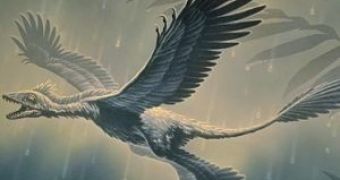
 14 DAY TRIAL //
14 DAY TRIAL // 
